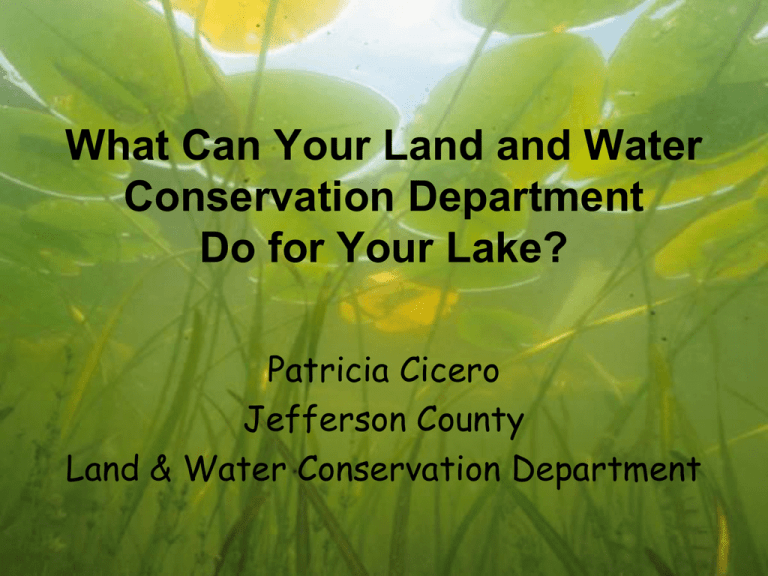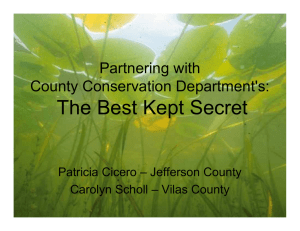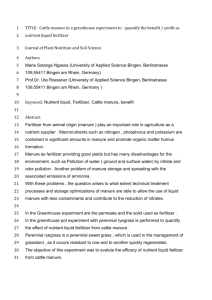What Can Your Land and Water Conservation Department Do for Your Lake?
advertisement

What Can Your Land and Water Conservation Department Do for Your Lake? Patricia Cicero Jefferson County Land & Water Conservation Department Intent of State Statute: Conserve Soil and Water Resources • Establishes erosion control goals • Provides for cost sharing, technical assistance, educational programs, etc. • Encourages coordinated planning and program implementation • Authority to enact ordinances • Creation of Land and Water Conservation Committees and Departments Each County has a Land and Water Conservation Department and Committee Each LWCD is Unique • Different number of employees • Different staff expertise • Different focus depending on resources, land uses Land and Water Resource Management Plans • Goals, Work Plan, Implementation Plan, Priority Areas, Enforcement Strategy • Requirement in every county • Updated every 5 years (may change) • Local Advisory Committee • Public Hearing County Budget Process • Departments submit budgets to County Board Finance Committee • Finance Committee holds series of meetings in September – public comment • County Board holds public hearing in October • County Board votes on budget in November Agriculture Conservation Planning • Farmland Preservation Program – tax credits to farm land according to plan ~60% of Jefferson County farmland Manure! Nutrient Management Plans • Requirement for every farm • Working Lands Initiative • Manure (and fertilizer) spreading plan: where, when, how much • Plan is based on crop needs and nutrients in soil • Surface and ground water protections • Restriction maps Restrictions: • Proximity to water • Slope of land • Vulnerable soil types • Wells • Direct conduits to water • Winter Manure Storage Ordinance • Build, Alter, Close Storage – need a permit • Review Plans • Inspection Authority • Stop Work Authority • NMP requirement Livestock Siting Law • 150 animal unit threshold, Jefferson Co. (500 elsewhere) • Dairy, beef, swine, poultry, sheep, goats • Odor Management • Waste & Nutrient Management • Waste Storage Facilities • Runoff Management Jefferson County’s Experience • 9 permits approved since 2006 • Application causes more long-term planning and environmental considerations • Public input is part of process; but cannot stop permit issuance unless application information is false Cost-Sharing Programs Cost-Sharing Programs • State = $20,400 in 2009, $20,000 in 2010 • State Nutrient Management = $30,000 in 2009, $12,874 in 2010 • Jefferson County = $23,400 in 2009, $8,675 in 2010 • Many Federal programs – NRCS, FSA • LWCDs, State, Federal governments provide technical assistance • Lake Group Involvement Shoreland Restorations Cost-Sharing with Lake & River Residents • 70% cost-sharing up to a cap ($4,000 in 2010) • Provide landscaper lists, and native plant lists • Perform inspections before, during, after • Some restorations are required through Zoning Cost-sharing lake and river shoreline erosion control Manure Management Prohibitions • No overflow of manure storage facilities • No direct runoff from a feedlot or stored manure into the waters of the state Manure Management Prohibition • No unconfined manure pile in a water quality management area – within 1,000 ft. from a lake; within 300 ft. from river or stream; or a site susceptible to groundwater contamination Manure Management Prohibition • No unlimited access of livestock to waters of the state such that maintenance of adequate sod or vegetative cover is prevented Manure Complaints • Investigate every complaint: information from citizen, visit site, look at nutrient management plans, ask for spreading logs • Approximately 85-90% of manure complaints are found to NOT be violations or problems • Inform farmers – better communications with neighbors • Educate citizens Manure Spreading Violations • Manure runoff to surface water – DNR Conservation Warden • Citations from DNR • Citations from Zoning if farm has a permit • Can require nutrient management plan ONLY with offer of cost-sharing or within Working Lands Initiative • Can add spreading restrictions to plan Construction Site Erosion • An acre under construction with no erosion control delivers, on average, as much sediment to local waterways as 75 acres of cropland. Lakes • Grants: Sponsor, Fiscal Agent, Matching Time • Meeting Facilitation • Collect, Summarize, and Explain Data and Information • Communicate with the Public • Communicate with Decision Makers • Mapping Capabilities • Develop Management Plans Lake Management Plans Opinion on Aquatic Plant Growth 60 TSI Secchi 1992 1994 1996 TSI Total Phosphorus 1998 2000 2002 2004 TSI Chlorophyll Support Ban on Phosphorus? 80 60 40 20 0 71.5 Yes 11.1 17.3 No No Opinion 2006 ni on 1990 O pi 1988 0.9 No 1986 2.0 Ch ok ed 1984 18.7 De ns e 30 4.8 He av y Oligot rophic 25.5 od er at e 40 48.1 M Mesot rophic 60.0 50.0 40.0 30.0 20.0 10.0 0.0 Li gh t Percentage 50 Percent Trophic State Index Eut rophic Aquatic Plant Surveys & Plans Lake Classification Shoreland Zoning Rules • Building Setbacks • Stairways • Boathouses • Shoreland Cutting • Shoreland Restoration lake monitoring, prevention and control of invasives, nonpoint source pollution, education, organizations NR 115 – Shoreland Rules • • • • • New State Minimum Standards Adoption by February 2, 2012 Public Process Zoning LWCD Research, Special Projects Effects of Pier Shading on NearShore Aquatic Habitat Researchers: Paul Garrison, DNR Dave Marshall, DNR Laura Stremick-Thompson, DNR Patricia Cicero, Jefferson County LWCD Paul Dearlove, Lake Ripley Mgmt. Dist. Plant Biomass 200 Ripley Rock grams 150 100 50 ND 0 Pier Deck Control • Water quality sampling on Rock Lake • Nutrient & sediment sampling on 2 streams • Recruit monitors for other lakes • Assist DNR with special projects Invasive Species • AIS Coordinators • Clean Boats/Clean Waters & AIS Monitoring Training • Garlic Mustard Control • Canada Geese Counts Year Canada Geese Counted 2002 347 2003 363 2004 449 2005 263 2006 362 Water Resources Staff • Not many Counties have a dedicated water resources staff person • DATCP staffing grants • DNR lake planning, protection, AIS grants – staffing money for specific project • Existing LWCD staff can diversify • Other ideas to fund position - multiple lake districts and associations, RC&Ds, sanitary districts, other related entities Enforcement of County/State Laws • Every County LWCD is different • Recent laws causing LWCDs to become more regulatory • Assistance from DNR Conservation Wardens, County Zoning Departments • One case – State Attorney General’s office Education Mapping Visit Your LWCD • • • • • Tell them what you/your group is doing Invite staff to meetings Ask LWCD what services they provide Talk about possible projects LWCDs can refer you to multiple experts and agencies Restoration at Executive Residence




